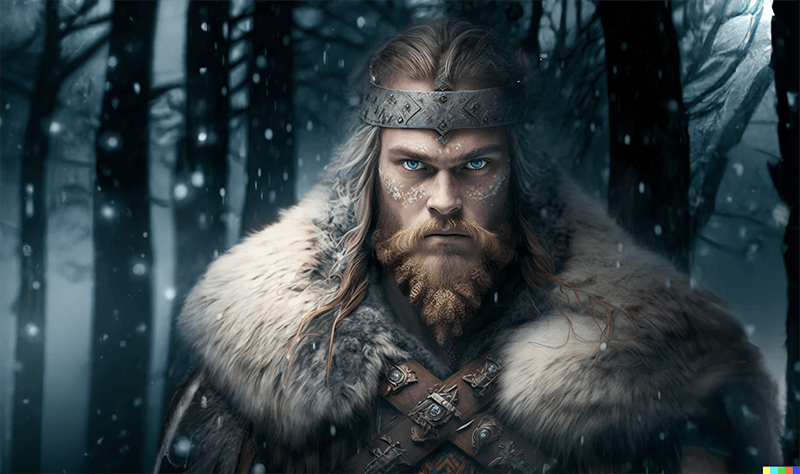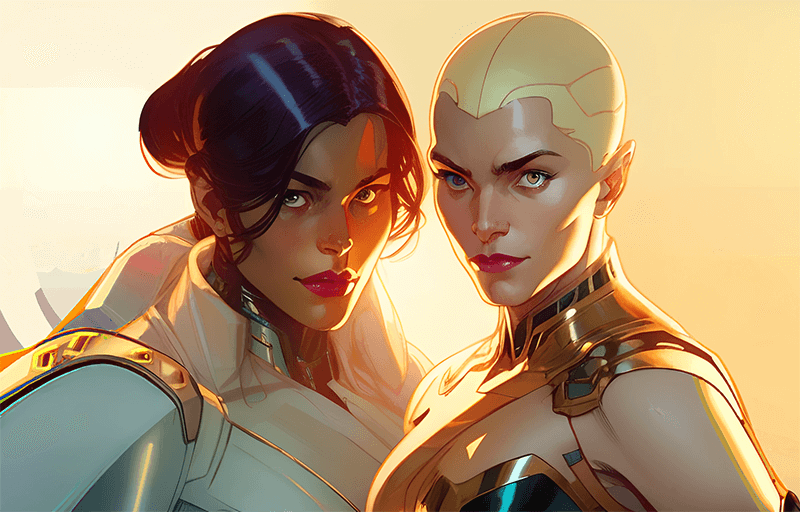Artificial intelligence is revolutionising the art world and the creative industry – not just in Denmark but around the world. And three new AI tools show the way forward for creative professionals: Midjourney AI, DALL-E and Stable Diffusion.
Here’s a video about artificial intelligence – and how you can make comics using Stable Diffusion.
What kind of artificial intelligence are we talking about here in the context of creativity and visual communication? AI stands for artificial intelligence. At a high level, it refers to the ability of a machine or computer system to perform tasks that would normally require human intelligence, such as understanding language, recognising images, creating pictures, making decisions and solving problems.
There are many different types of AI, ranging from simple rule-based systems to more complex machine learning algorithms that can learn and adapt on their own.

AI writes thousands of articles!
You may have already read lots of articles in newspapers, magazines and online information without knowing that the first draft of what you have read was written by AI – that is, artificial intelligence. Because most news media and online magazines already use chat bots like GPT-3 to write parts or whole articles.
At the same time, chat bots are becoming more adept at customer service tasks, for example, where you are first screened by artificial intelligence before being passed on to a real employee.
Will artificial intelligence replace humans?
But so what. Will humans eventually be replaced by artificial intelligence? If you ask a human like Elon Musk, the answer will probably be yes. But, while the man is fiercely forward-thinking, he’s not exactly known for living completely in tune and in touch with the outside world. So in the long term, we have no idea what will happen with artificial intelligence.
The way the world is turning right now, image-creating artificial intelligence is not going to replace the human aspect. It cannot at this point replace the artist or the creative professional.
For example, at present we can use AI for 5% of our customer tasks. But in the longer term, that figure will be a lot higher.
Instead, artificial intelligence like Midjourney, DALL-E and Stable Diffusion should be seen more as tools that artists can use to work faster, smarter – and make artworks, drawings, animations or similar better and more beautiful.
But why can’t you use it more than 2% at a time? It’s because of the way AI works. These AIs learn to create images from noise by learning from pre-existing images – and by creating noise on top of those images – and then recreating them again via a kind of de-noising. In this way, the AI learns to create images.
This means that working with AI is a bit like having an illustrator work for you. You can (using text) ask for what you want. You can also make picture 2 picture prompts and a lot of other things. But so far, AI still struggles to create consistent characters across panels and frames. And it struggles to create nice (and normal) hands, feet and eyes.
It’s quite possible to correct and give a new prompt. But the AI will generate new images every time. That means it’s hard to create the same character in new perspectives, situations and seen from different angles.

WHAT DOES IT MEAN FOR CREATIVE PROFESSIONALS?
Some artists and creative professionals are panicking about the new technology – and fear it will put many out of work. Because if you can create digital artworks with a computer, what’s the point of creatives?
At Levende Streg, we see it differently. Artificial intelligence is a really good TOOL that boosts creative output – and can make drawings, 3D renderings, animations, sketches and comics even better. At the same time, it can provide new and creative input. But it doesn’t replace the human behind it. Not yet, anyway.
There are a number of reasons why some people may be afraid of artificial intelligence. One reason is that they may be concerned about the potential negative consequences of AI, such as job losses due to automation or the possibility that AI systems behave in ways that are harmful to humans.
Another reason may be a general fear of the unknown or a feeling that AI systems are not fully understood and can potentially behave unpredictably. In addition, some people may be concerned about the ethical implications of AI, such as the possibility of AI systems being used to violate privacy or other ethical standards. Finally, some people may be concerned about the possibility of AI becoming more intelligent than humans and potentially posing a threat to our existence.
WILL IT UNDERMINE ART?
Some might argue that these AI technologies enable ordinary people to create art – even if they are not artists. Others fear that the market for art and creativity will now be flooded with “bad” art.
But it should be said that just because you like food doesn’t make you a gourmet chef. And similarly, there is a high learning curve with artificial intelligence. It’s rare that you can go from never having tried working with AI – to creating something that’s useful to sell on to customers.
Instead, imagine if these tools could help artists or creative professionals improve their work and help create art that is more diverse, creative and thought-provoking than ever before. The results can be amazing and thought-provoking, and they are pushing the boundaries of what is possible in the art world.
But what kinds of artificial intelligence are we talking about here? And how do you get started using it?
MIDJOURNEY AI FOR GENERATING AI
Midjourney AI is an advanced AI platform designed to help artists create and explore new ideas. It works through the Discord app – a platform designed to be user-friendly and intuitive – where artists can ask a bot to generate images for them.
Midjourney AI is an advanced AI platform designed to be user-friendly and intuitive. It is accessible to artists of all levels and can help them unleash their creativity and create new works of art that are original and thought-provoking.
This can be a valuable tool for artists who want to break out of a creative routine, or who want to push their art in new and exciting directions.
The really big advantage of Midjourney is that it’s pretty easy to get working – and it’s fairly easy to operate compared to Stable Diffusion (see more below). But it’s still hard to get it all to work – and it’s not at all as intuitive as, say, Adobe’s programs.
DALL-E (DALI)
DALL-E (pronounced like Salvador Dali) is another AI technology used to create art. Developed by the OpenAI team, DALL-E is a powerful neural network trained on a massive dataset of images.
When given a description of an image, DALL-E can generate a new image that matches the description. This can be used to create art that is imaginative and surreal, with a level of detail and complexity that is beyond the reach of human artists.
Watch a video on how to use AI to correct your drawings.
STABLE DIFFUSION
Stable Diffusion is a third AI technology used for art generation. And it’s probably the most popular. Developed by researchers at the University of California, Berkeley, Stable Diffusion is a machine learning algorithm designed to create smooth, organic-looking shapes and patterns.
By combining Stable Diffusion with other AI tools, artists can create art that is intricate and elegant with a fluid, natural quality that is difficult to achieve with traditional artistic techniques.
The potential of Midjourney AI, DALL-E and Stable Diffusion for art generation is enormous. These AI technologies enable artists to create works that are bold, original and thought-provoking.
WHAT IS INPAITING OG OUTPAINTING?
At present, inpainting and outpainting are probably some of the most useful things about AI. For they enable artists to correct or extend their artworks.
Most animators have sat with a background in a movie where they just needed to zoom out a little more – to see the bigger picture. But no more of the background is drawn. Now AI can help. And it’s called outpainting. I’m sure it’ll be part of Adobe’s software in the near future.
The terms “outpainting” and “inpainting” are used in the context of AI art generation, in relation to the DALL-E and Stable Diffusion AI tools. So far, Midjourney does not support this feature.
In contrast, the “inpainting” process involves filling in missing parts of an existing image – or correcting details. Imagine you’ve seen a mistake in your drawing that you’ve made in Photoshop. AI can now help correct it – just by using text prompts.
In general, the “outpainting” and “inpainting” processes are important aspects of AI art generation. These processes allow artists to create new artworks based on their own ideas and concepts or to complement and enhance existing images.
At the same time, inpainting and outpainting are an essential part of, for example, creating comics or sequential art. And it will be a valuable tool for many artists and cartoonists. You can follow the evolution of AI and artificial intelligence – and how we use it creatively.